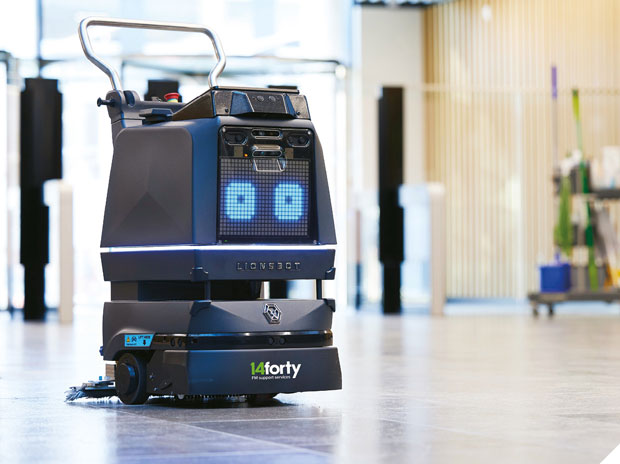Mauro Ortelli, Managing Director, 14forty, examines the key benefits that working with collaborative robots, or cobots, brings to the FM sector and looks at some of the challenges
Relationships between humans and robots are becoming increasingly important. From driverless vehicles and chess-playing automatons to robotic hotel receptionists and waiters, the sci-fi vision of humans and androids coexisting happily together is fast becoming less of a fantasy.
In many respects, the facilities management sector is leading the charge. Collaborative robots – or cobots – are now expanding beyond conventional production roles, where they might handle materials, monitor assembly lines, or pick up and place. They’re revolutionising many areas within facilities management with their ability to work alongside humans and improve efficiency, precision and safety.
It’s easy to see why they’re becoming so popular. They have the potential to reduce costs, improve efficiency and automate tedious tasks.
They can also help with the industry’s current labour shortage by maximising productivity and covering for vacancies – but at a higher productivity rate, which is good for the bottom line. And, just as importantly, they free up human beings to undertake more complex and interesting tasks.
This all goes to show that Cobots offer the answer to so many of the issues currently facing the facilities management soft services sector, but we need to manage their introduction in an empathetic and responsible way.
ARE COBOTS CLEANING UP?
Cobots offer significant advantages in terms of productivity enhancement. When compared to manual floor-mopping, for example, which typically covers around 250 square metres an hour, modern cobots can achieve nearer 1,000 square metres per hour.
But rather than replacing humans, cobots – as the moniker indicates – work best when operating in tandem with the ‘real’ workforce. For instance, by assigning cobots to work on larger spaces, the rest of the cleaning team can focus on more intricate areas, such as desks and washrooms, addressing any detailed cleaning requirements.
We know the facilities management sector is struggling with talent acquisition at the moment. So, we all need to think about the experience we’re offering to potential team members. Alongside salary, many are looking for greater flexibility and by creating a complementary cobot operation, that agility can be accommodated more easily. Integrating the technology into the workforce can provide the flexibility that people are demanding while deploying cobots strategically also reduces the number of hours needed to complete tasks. This can enable potential increases in hourly rates – a further plus point for potential employees, which helps to attract and retain talent in this competitive market. While this approach helps manage inflationary pressures related to labour costs, it’s crucial to emphasise that cobots are not intended to replace humans. The true essence of cobotics lies in humans and cobots working side by side to deliver optimal services.
Shifting to this collaborative mindset requires a change in thinking for both cleaning teams and clients, but once embraced most have been impressed by the consistent quality achieved. Currently, 81 per cent of facilities management leaders see cobotics as a potential solution to cleaning challenges over the next five years, and 73 per cent believe cobots have the potential to ‘transform the cleaning industry’ [IFMA and Softbank Robotics].
Visit Compass House in Chertsey and one of the first team members you’ll meet is 14forty operative Hanzel. But Hanzel isn’t a person, he’s a scrubber-dryer cobot. He’s responsible for cleaning tiled floors at the site and, when in mingle mode, does an excellent job of entertaining colleagues and visitors in reception too. He’s become a popular and familiar face, and an interesting first step into cobotics at 14forty.
He might ask a question, make a statement, or even sing a song. You never know what’s coming next and people find it hugely entertaining. It’s been good for team morale and has also built relationships with clients and prospects. It’s like bringing a dog to work – it makes everyone feel better.





